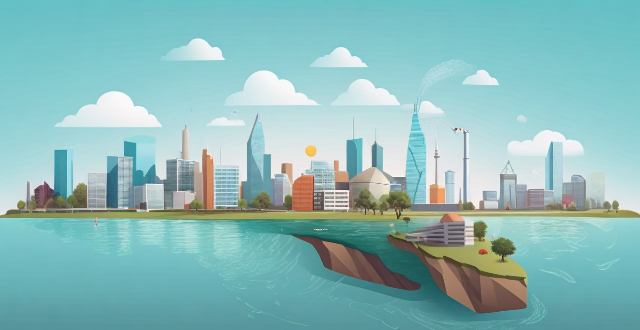The text discusses the impact of urbanization and land use change on ecosystem services, including provisioning, regulating, cultural, and supporting services. It highlights how these changes can lead to decreased water supply, reduced food production, negative effects on climate regulation and flood control, loss of recreational opportunities and cultural values, and disruption of soil formation and nutrient cycling. Mitigation strategies such as green infrastructure, sustainable urban planning, and land stewardship are suggested to minimize these negative impacts and maintain essential ecological functions.

The Impact of Urbanization and Land Use Change on Ecosystem Services
Urbanization and land use change are two interconnected phenomena that have significant impacts on ecosystem services. These services include provisioning (such as food and water), regulating (like climate regulation and flood control), cultural (recreational and spiritual benefits), and supporting services (soil formation and nutrient cycling). Here's a detailed exploration of how these processes affect ecosystem services:
Provisioning Services
- Water supply: Urbanization often leads to increased impervious surfaces, reducing the capacity of the landscape to absorb and filter water. This can lead to decreased groundwater recharge and altered surface water flows, affecting both quality and quantity of water available for human use.
- Food production: As land is converted from agricultural to urban uses, there is less space for farming, which can decrease local food production. However, urban agriculture initiatives can partially offset this loss.
Regulating Services
- Climate regulation: Trees in urban areas can help sequester carbon, but urban heat island effects and reduced vegetation cover can also increase local temperatures, affecting climate regulation negatively.
- Flood control: With less permeable soil and fewer wetlands due to urban development, the ability of an area to absorb and slow down floodwaters is diminished, increasing risks of flooding.
Cultural Services
- Recreation and mental health: Urban green spaces provide critical recreational opportunities and contribute to mental health. However, the loss of natural areas can reduce these benefits.
- Aesthetic and cultural values: Urban sprawl can lead to the loss of culturally significant landscapes and biodiversity, reducing the aesthetic and cultural value people derive from nature.
Supporting Services
- Soil formation and nutrient cycling: Construction and paving over natural lands disrupt these processes, leading to degraded soil quality and reduced fertility for remaining natural and agricultural areas.
- Habitat for wildlife: Urban development fragments habitats, reducing biodiversity and ecosystem resilience. This affects the functioning of ecosystems and the services they provide.
Mitigation Strategies
To mitigate the adverse effects of urbanization and land use change on ecosystem services, several strategies can be employed:
- Green infrastructure: Incorporating green roofs, parks, and other vegetated areas into urban designs can help maintain ecological functions within cities.
- Sustainable urban planning: Planning that considers ecosystem services, such as preserving critical natural areas and incorporating biodiversity corridors, can minimize negative impacts.
- Land stewardship: Practices like conservation easements and reforestation can protect and restore ecosystem services in affected landscapes.
In conclusion, while urbanization and land use change pose challenges to ecosystem services, proactive planning and conservation efforts can help balance the needs of urban development with the maintenance of essential ecological functions.